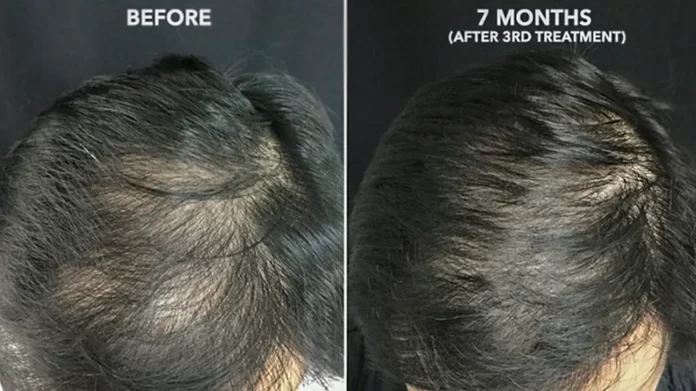Hair loss is a common concern that affects millions of people worldwide. From over-the-counter remedies to surgical hair transplant procedures, there’s a wide range of treatments available for those looking to restore their locks. Platelet-Rich Plasma (PRP) therapy has gained popularity as a non-surgical, minimally invasive option for hair loss.
In this comprehensive guide, we’ll delve into the world of PRP therapy for hair loss, exploring its effectiveness, the science behind it, and what you can expect from this innovative treatment.
Table of Contents
What is PRP Therapy for Hair Loss?
Platelet-Rich Plasma (PRP) is a concentrated form of your blood that contains a higher concentration of platelets than what’s typically found in the blood. Platelets are cells known for their healing properties, as they release growth factors and proteins that help cells grow and repair tissue.
When used in PRP hair restoration, this plasma is injected directly into the scalp, aiming to stimulate dormant hair follicles, enhance blood circulation, and promote new hair growth.
The Science Behind PRP Therapy
To understand the effectiveness of PRP therapy for hair loss, it’s important to grasp the science behind it. The growth factors in PRP, such as platelet-derived growth factor (PDGF), transforming growth factor-beta (TGF-β), and vascular endothelial growth factor (VEGF), are key players in tissue repair.
When PRP is introduced into the scalp, it acts as a catalyst, prompting a natural response within your body. These growth factors play a key role in reviving the activity of your hair follicles. They extend the anagen phase, which is the growth phase of the hair cycle, while discouraging premature entry into the telogen phase, the resting stage. In simpler terms, PRP therapy coaxes your hair follicles to produce hair that’s not only healthier but also thicker and more abundant..
The PRP Therapy Procedure
PRP therapy for hair loss is a straightforward and minimally invasive procedure. Here’s what you can expect during the treatment:
Blood Collection
A small amount of your blood, typically a few vials, is drawn from your arm.
Processing
The collected blood is placed in a centrifuge, a machine that separates the components of the blood. This process isolates the PRP from the rest of the blood.
Injection
The PRP, now in a concentrated form, is injected into the targeted areas of the scalp with a fine needle. Your healthcare provider will determine the specific areas based on your pattern of hair loss.
Recovery
PRP therapy is an outpatient procedure, and you can typically resume your regular activities immediately after the treatment.
Does PRP Therapy Work for Hair Loss?
The effectiveness of PRP therapy for hair loss has been a subject of significant research and debate. The results can vary from person to person, and several factors influence the outcome of PRP treatments. Here are some key considerations:
Stage of Hair Loss
PRP therapy tends to be most effective in the early stages of hair loss when the hair follicles are still active. It can slow down or even reverse hair thinning.
Consistency
Multiple sessions of PRP therapy are often required to achieve and maintain the desired results. This treatment is not a one-time fix, and ongoing maintenance may be necessary.
Combination with Other Treatments
Some individuals choose to combine PRP therapy with other hair loss treatments, such as topical minoxidil or finasteride, for enhanced results.
Individual Response
How your body responds to PRP therapy can vary. While some people experience significant improvements in hair growth, others may see more modest results.
Skilled Practitioner
The experience and skill of the practitioner administering the PRP treatment can significantly impact its effectiveness. Choosing a qualified and experienced healthcare provider is crucial.
PRP vs. Traditional Hair Transplants
One common question that arises when considering PRP therapy for hair loss is how it compares to traditional hair transplant procedures, such as Follicular Unit Transplantation (FUT) or Follicular Unit Extraction (FUE).
PRP Therapy:
- Non-surgical and minimally invasive.
- Uses the patient’s own blood.
- Encourages hair follicles to grow thicker and healthier hair.
- Requires multiple sessions for optimal results.
- Best suited for early-stage hair loss and as a complementary treatment.
Traditional Hair Transplants:
- Surgical procedure involving the transplantation of hair follicles from one area of the scalp to another.
- Provides permanent results.
- Ideal for advanced hair loss or for those seeking a one-time, surgical solution.
- Requires a longer recovery period.
What to Expect After PRP Therapy
After undergoing PRP therapy for hair loss, it’s important to have realistic expectations. Here’s what you can anticipate:
Results Over Time
Hair growth following PRP therapy is a gradual process. You may start to see improvements after a few months, with the most noticeable changes occurring several months after treatment.
Maintenance
To maintain the results, periodic PRP sessions are often recommended. The frequency of these sessions will depend on your individual response and the recommendation of your healthcare provider.
Potential Side Effects
PRP therapy is generally safe with minimal side effects. Some individuals may experience mild swelling or discomfort at the injection site, but these effects are usually temporary.
Consultation
It’s essential to have a thorough consultation with a qualified healthcare provider who specializes in PRP therapy for hair loss. They can assess your specific situation and provide personalized guidance.
Summing Up
PRP therapy for hair loss is a non-surgical, minimally invasive procedure that holds promise for individuals seeking to combat hair thinning and promote hair growth. While the effectiveness of PRP therapy can vary from person to person, it has shown positive results for many. It’s important to have realistic expectations, understand that multiple sessions may be necessary, and consult with a skilled healthcare provider who can tailor the treatment to your unique needs.
As with any medical procedure, it’s crucial to do your research, seek professional advice, and make an informed decision about whether PRP therapy is the right choice for addressing your hair loss concerns. Ultimately, the decision should be based on your individual circumstances, goals, and the guidance of a qualified practitioner.







